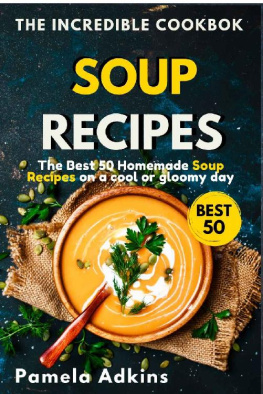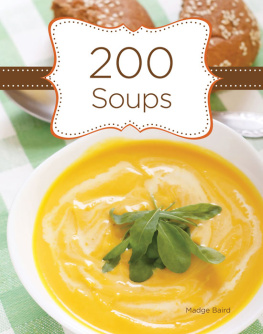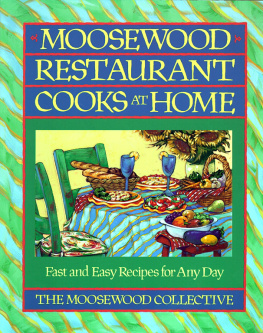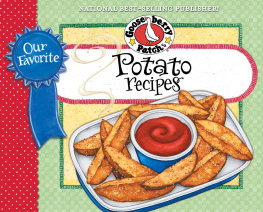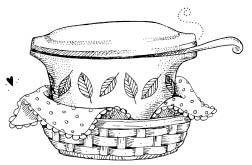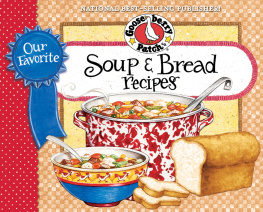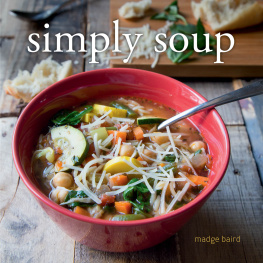
Thank you for purchasing this Scribner eBook.
Join our mailing list and get updates on new releases, deals, bonus content and other great books from Scribner and Simon & Schuster.
C LICK H ERE T O S IGN U P
or visit us online to sign up at
eBookNews.SimonandSchuster.com

SCRIBNER
1230 Avenue of the Americas
New York, NY 10020
www.SimonandSchuster.com
Copyright 2003 by Tom Valenti and Andrew Friedman Photographs copyright 2003 by Beatriz da Costa
All rights reserved, including the right of reproduction in whole or in part in any form.
SCRIBNER and design are trademarks of Macmillan Library Reference USA, Inc., used under license by Simon & Schuster, the publisher of this work.
Designed by Kyoko Watanabe
Text set in Stone Serif
Library of Congress Cataloging-in-Publication Data
Valenti, Tom, date.
[Soups, stews, and one-pot meals]
Tom Valentis soups, stews, and one-pot meals: 125 home recipes from the chef-owner of New York Citys
Ouest and Cesca / Tom Valenti and Andrew Friedman.
p. cm.
Includes index.
1. Soups. 2. Stews. 3. Casserole cookery. 4. Cookery, Italian. I. Friedman, Andrew, date. II. Title.
TX757.V35 2003
641.8'21dc22
2003054479
ISBN 0-7432-4375-7
ISBN-13: 978-0-7432-5354-3 (eBook)
for Abigail,
T.V.
for Caitlin,
A.F.
This Book Does Not ...
... call for hard-to-find ingredients;
... feature recipes within recipes;
... insist that you replicate complicated, origamilike presentations;
... assume that you can afford white truffles, caviar, or Kobe beef;
... ask you to eat sea urchin or blowfish;
... suggest vintage-specific wine pairings; or
... plug a line of bottled products.
Its mission is to share recipes for home meals that are simply preparedmost in a single vesseland a chefs tips for making them as delicious as possible. Thats it.
Contents
Tom Valenti is a lot like me. We both hail from working-class Italian-American families. We both loved sports growing up (and still do). We both live happy lives cooking for the greatest customers in the world in New York City. We both love to fish and we both love to take naps. We both love to cook at our restaurants and at our homes. We both love big gutsy flavors and layers and layers of them in every dish we create. We both would prefer to be known for our grandma style of cooking than for anything cutting-edge. We both represent the Italian ideal of hospitality and live for our love of the table and the time spent there with friends and family. We both understand the value of food as substance more than just something to eat. We both work with excellent charities outside of our restaurants and feel great about that.
... And we both hate doing the dishes.
This new book attacks the dishes issue head on. I find it deplorable that at the end of every great meal there is the equivalent of a prison sentence of an hour or more of cleanup for some unlucky soul. At our restaurants, we both have teams of people near us at all times to wipe up our every spill, to polish our fancy wine glasses, and to buff the silver. At home we have only ourselves.
The reality of cooking at home is not only that of the cleanup, it is also an issue of our most precious commodity: free time. Really great food does not have to take all day to prepare. Although they may need to simmer on the back burner for several hours on low heat, many of my favorite dishes take literally thirty minutes of real effort to get going. What that leaves is twofold: a great dish filled with exquisite and complex layers of poetic flavor and the ethereal texture of the best of grandmas cooking and the reality of a clean kitchen at dinnertime with but one pot and some plates to clean.
Its not that cleanup is such a crucial issue, because in fact I can always cajole someone into doing the dishes in exchange for dinner. It is more a matter of quality of life. The foods that come out of a single pot reflect the love of sharing and a time for family and the feelings of goodness that surround and envelop a table of people breaking bread in a near sacred hymn of ritual and simplicity. Conversely, it speaks to the modern family on the go, where dinners are often reheated three or four times a night, for each lone ship passing through the kitchen for just enough time to refuel. In this case a simmering pot of something great is a guarantee of higher quality food, even if quality time is less of a priority than it could be.
It may seem like slumming for one of New York Citys greatest chefs to take on the Crock Pot, unless you really look at the menus in his instantly hot two restaurants, Ouest and Cesca. Deep behind the menu-speak describing the modern American and Italian ingredients in his timeless dishes, there lurks the real truth about Tom Valentis cooking: each item is either cooked two minutes or two hours. The two-hour items are what make Toms and my cooking so similar and so tasty, the two-minute items are what allow our restaurants to thrive. To understand that these two strategies can and should go together is critical in developing a strategy for cooking at home. Some things will take some time to cook into a potful of poetry. Other things take just a couple of minutes of prep to get ready. This is good. And there are some things, like a perfect plum or deliciously al dente spaghetti with oil and garlic, that are all about the shopping and not at all about the cook. In Toms and my world, putting them all together makes for great food, and it should in yours.
So use this book with the same sense of humor and fun that Tom and I put into our daily adventures in cooking, buy the freshest ingredients you can find, use the recipes as road maps as opposed to exact surgical diagrams, and relax. There wont even be too much cleanup. Then you can eat just like Tom and I.
Mario Batali
Picture this: Its late in the evening. Youre sitting in the living room, enjoying the company of family and friends, and savoring the final moments of a dinner party that began hours ago. Everything has been just perfect and everyone is so comfortable and sated that, if it were socially acceptable, they would close their eyes and nod off right there. Instead, they push themselves up out of their chairs, say goodnight, and retire to their cars or bedrooms.
You make your way around your home, turning off lights, closing windows. But then you reach the kitchen, and that warm, satisfied feeling deserts you as youre reminded of the monumental cleanup that awaits. Pots and pans have been turned every which way to fit into the sink; the last ones you used remain on the stovetop with remnants of meat and sauce encrustedfor eternity, or so it seemsonto their surfaces. Your heart sinks. Your elbow and wrist begin to ache at the mere contemplation of the task before you. Whether you tackle it tonight or leave it for the morning, one things for sure: It aint gonna be fun.
To be perfectly honest, as much as anything else, this book began with my dread of that moment. Chefs probably hate washing dishes and scrubbing pots and pans more than anyone because there are people who do it for us in our restaurants. We live in a world where the supply of clean pots and pans is limitless and dirty ones simply dont exist. When were done cooking, were done working.
This is every bit as appealing as it sounds, and it gets even better: As you might know, we also have prep cooks who wash and pick the leaves from herbs, cut onions, make stocks, and so on. In other words, when Im on the job, I can focus exclusively on the dish before me, drawing from prechopped and precooked ingredients.
Next page



